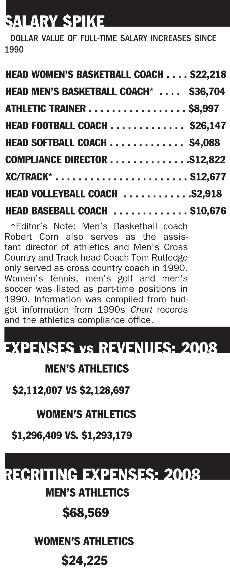Gender gap narrows in University athletics

Gender gap narrows in University athletics
At a time when parity in salaries and opportunities for each gender is expected, Missouri Southern athletics appears to be closing the gap.
The University offers six sports for each gender, with women’s soccer, added before the 1999 season, being the last addition. Athletics Director Sallie Beard thinks there is a fair balance. It wasn’t always this way, though.
“Back in 1974 I was approached by a group of young women who came to me and said ‘we want to play basketball,’ and so basketball was started,” Beard said. “In that same year they came back to me and said ‘we’d like to have tennis, we’d like to have softball.’ There was enough interest, enough synergy if you will, and those sports were added.”
According to the fiscal year 2009 sports budget, women’s teams and the women’s athletic office will receive $233,888, while the men’s teams and men’s athletic office are slated for $388,179. The difference may seem large, but males represent the majority of athletes on campus with 291 total participants, compared to 173 total female participants.
“It’s a numbers thing,” Beard said. “Male athletes represent about two-thirds of the total population of student athletes.
“Men are always going to get more,” she added. “It’s largely a function of the number of athletes in football. On the women’s side there’s nothing that compares to that. There’s nothing even on the rest of the men’s side that compares to that.”
There are 108 athletes on the football team, followed by 87 on men’s track and field and cross country combined. Baseball has 42 participants, followed by men’s soccer with 25, basketball with 17 and golf with 12. The largest team on the women’s side is track and field and cross country combined with 97 athletes, followed by 20 softball participants. Soccer has 19 athletes, volleyball 16, basketball 13 and tennis has eight.
“If you look at the per capita expenditure, football is very blue collar in terms of what it spent per capita,” Beard said. “If you did a per capita comparison between the football players and the basketball players or even golf, those athletes on the other sports have much more spent on them
Both men’s and women’s sports have six head coaches each. The average salary for head coaches in men’s sports is $40,919, while women’s head coach salaries average $34,455. There are 11 assistant coaches for women’s teams, averaging $16,439 per year, and 16 head coaches for men’s teams, averaging $14,972.
Beard said several factors must be taken into account when figuring coaching salaries.
“You have to look at years of service, what are the ages of those coaches, what experience do they bring to the table when you first hire them,” she said. “So to look at a dollar figure only tells you a piece of the puzzle. Do I think we are equitable in our pay scale? Yes.”
Again, it hasn’t always been as equal for women at Southern, but Beard said there has been an effort in the last 10 to 15 years to make women’s salaries more on par with men’s.
“I don’t think I can pinpoint any particular year where we said we’ve got to fix this,” she said. “It comes under review naturally anytime we make a new hire, whether that be a head coach or an assistant coach.”
Beard also said the University has never considered dropping a sport.
“I’ve never had anyone from the administration approach me with that proposal,” she said.
Your donation will support the student journalists of Missouri Southern State University. Your contribution will allow us to purchase equipment and cover our annual website hosting costs.



























